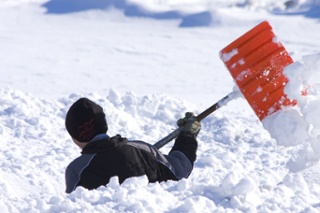Winter is officially here and with it comes the chance of extremely cold weather and winter storms. Winter storms and winter weather can be very dangerous to you and your family if the proper precautions aren’t taken. Winter storms can knock out heat and power, which could leave your family stranded and exposed to the extreme conditions. Here’s how you can prepare your family for the season of winter storms.
Before a Winter Storm
One of the best ways to be prepared for the winter is by getting together an emergency kit before the season hits. Some of the things to include in this kit are salt to melt ice on sidewalks, sand to improve traction, snow shovels or snow blowers, heating fuel or firewood, and clothing and blankets for warmth. You should also come up with a family plan just in case you aren’t together when a storm hits. Make sure all family members know what to do and how they will contact one another. You will also want to pay attention to the radio and television to get any updates on the winter weather so that you know what to expect. Finally, you should most definitely winterize your home before the winter storm season hits. Here are some ways to winterize your home:
- Insulate walls and attics
- Caulk weather-stripping doors and windows
- Install storm windows or cover windows with plastic
- Clear rain gutters
 Repair roof leaks
Repair roof leaks- Cut tree branches that could fall on your home during a storm
- Have your heating source or chimney cleaned and checked
- Insulate pipes
- Allow faucets to drip a little to avoid freezing
- Make sure fuel-burning equipment is vented outside
- Keep a fire extinguisher in your home
- Make sure family members know how to shut off water valves
- Hire a professional to check the structure and stability of your roof
During a Winter Storm
When a winter storm hits, it is best that you stay in your home. If you must go outside for any reason, walk carefully on icy/snowy sidewalks and dress appropriately for the weather. If the pipes in your home freeze during the storm, remove any insulation that you added to the pipes. Open all of your faucets and pour hot water over the pipes. When you pour the hot water you should start where the pipes were, or you suspect were, most exposed to the cold. Next, you want to make sure that you maintain ventilation if you are using kerosene heaters. Refuel the heaters outside and keep them at least three feet from flammable objects. Finally, make sure you conserve any fuel that you have by keeping the thermostat at a lower temperature than you normally would. You can also close off heat to rooms you may not use as much in order to conserve some fuel.
After a Winter Storm
If the storm passes and your home has lost power or heat you may need to relocate until your home becomes safe again. You may want to contact your local power and electric companies to get an estimate of how long your power or heat will be out. If you must leave your home, make sure you are cautious when driving and make sure you dress warmly by wearing layers, gloves, scarves, hats, etc. If you had to use any of the supplies from your emergency kit make sure you restock it immediately.
Winter storms can be pretty unpredictable so it is important to be prepared for any extreme. Get your home ready for the winter storm season before it’s too late.
Resources
- http://www.ready.gov/winter-weather
- https://www.milavetzlaw.com/winter-storm-safety-what-you-need-to-know/
Have a pet? Check out this article: https://betterpet.com/cold-weather-pet-care/
